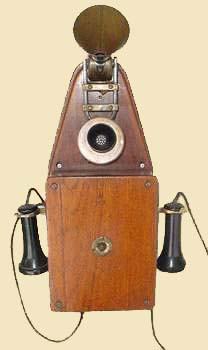 Phonopore Phonopore
These were large British-made phones, dating from the late 1890s. This example,
because of its simpler case styling and "A" series case number, is probably from the late 1890s. During this
period they were made by the New Phonopore Company, and later by Sterling Telephone and Electric, who bought out the
Phonopore company. It has also been partly rebuilt by one of the Railways workshops
- the railways administrations tended to recondition their equipment for as
long as possible. The Phonopore is unusual for a number of reasons. It was not used through a
telephone exchange, but was connected across the railways Morse telegraph lines.
An extra coil was needed to block the Morse code from being heard through the
receiver, and this coil could be wound into the standard receiver. Conventional bells could not be used as the ringer pulses would interfere with
the Morse code, so a Collier-Marr receiver was fitted (the barrel, magnet and
large trumpet at the top). Although it was designed as a receiver, if a suitable
signal was applied it would make a noise likened to the harsh squawking of a
crow. Later models used a "howler" instead. Over the years, many were rebuilt by the Railways workshops around the world,
but were eventually taken out of service as teleprinters and telephones replaced
them. They are now rare. My example is missing some of its internals , but I
am slowly rebuilding it.
 If you have reached this page through a Search Engine, this will take you to the front page of the website If you have reached this page through a Search Engine, this will take you to the front page of the website
|